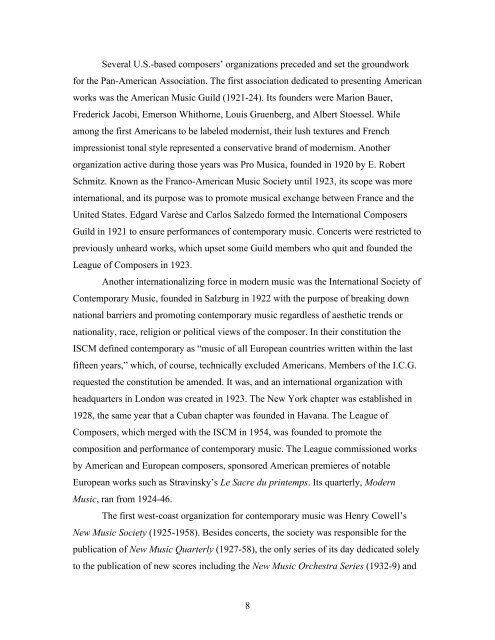Collective Difference: The Pan-American Association of Composers
Collective Difference: The Pan-American Association of Composers
Collective Difference: The Pan-American Association of Composers
You also want an ePaper? Increase the reach of your titles
YUMPU automatically turns print PDFs into web optimized ePapers that Google loves.
Several U.S.-based composers’ organizations preceded and set the groundwork<br />
for the <strong>Pan</strong>-<strong>American</strong> <strong>Association</strong>. <strong>The</strong> first association dedicated to presenting <strong>American</strong><br />
works was the <strong>American</strong> Music Guild (1921-24). Its founders were Marion Bauer,<br />
Frederick Jacobi, Emerson Whithorne, Louis Gruenberg, and Albert Stoessel. While<br />
among the first <strong>American</strong>s to be labeled modernist, their lush textures and French<br />
impressionist tonal style represented a conservative brand <strong>of</strong> modernism. Another<br />
organization active during those years was Pro Musica, founded in 1920 by E. Robert<br />
Schmitz. Known as the Franco-<strong>American</strong> Music Society until 1923, its scope was more<br />
international, and its purpose was to promote musical exchange between France and the<br />
United States. Edgard Varèse and Carlos Salzedo formed the International <strong>Composers</strong><br />
Guild in 1921 to ensure performances <strong>of</strong> contemporary music. Concerts were restricted to<br />
previously unheard works, which upset some Guild members who quit and founded the<br />
League <strong>of</strong> <strong>Composers</strong> in 1923.<br />
Another internationalizing force in modern music was the International Society <strong>of</strong><br />
Contemporary Music, founded in Salzburg in 1922 with the purpose <strong>of</strong> breaking down<br />
national barriers and promoting contemporary music regardless <strong>of</strong> aesthetic trends or<br />
nationality, race, religion or political views <strong>of</strong> the composer. In their constitution the<br />
ISCM defined contemporary as “music <strong>of</strong> all European countries written within the last<br />
fifteen years,” which, <strong>of</strong> course, technically excluded <strong>American</strong>s. Members <strong>of</strong> the I.C.G.<br />
requested the constitution be amended. It was, and an international organization with<br />
headquarters in London was created in 1923. <strong>The</strong> New York chapter was established in<br />
1928, the same year that a Cuban chapter was founded in Havana. <strong>The</strong> League <strong>of</strong><br />
<strong>Composers</strong>, which merged with the ISCM in 1954, was founded to promote the<br />
composition and performance <strong>of</strong> contemporary music. <strong>The</strong> League commissioned works<br />
by <strong>American</strong> and European composers, sponsored <strong>American</strong> premieres <strong>of</strong> notable<br />
European works such as Stravinsky’s Le Sacre du printemps. Its quarterly, Modern<br />
Music, ran from 1924-46.<br />
<strong>The</strong> first west-coast organization for contemporary music was Henry Cowell’s<br />
New Music Society (1925-1958). Besides concerts, the society was responsible for the<br />
publication <strong>of</strong> New Music Quarterly (1927-58), the only series <strong>of</strong> its day dedicated solely<br />
to the publication <strong>of</strong> new scores including the New Music Orchestra Series (1932-9) and<br />
8
















